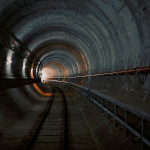World Tunnel Day Date in the current year: December 4, 2026
 World Tunnel Day is celebrated annually on December 4. It was created to raise awareness of the role of tunnels in modern infrastructure and their impact on our daily lives, and to promote the tunneling industry among engineering students.
World Tunnel Day is celebrated annually on December 4. It was created to raise awareness of the role of tunnels in modern infrastructure and their impact on our daily lives, and to promote the tunneling industry among engineering students.Tunnels are relatively long and narrow underground or underwater passageways dug through surrounding soil, earth, or rock, or laid underwater. They have existed since ancient times; the earliest known tunnel excavated from both ends is the Siloam Tunnel (Hezekiah’s Tunnel), a water tunnel in East Jerusalem dating from the 8th–7th centuries BC. Much of the early tunneling technology evolved from mining and military engineering.
Today, tunnels can serve a variety of purposes. For example, they are widely used in transportation, accommodating pedestrian or vehicular traffic, rail systems, or canals. In many rapid transit systems, the central sections are usually located in underground tunnels. Tunnels are used in mining (specifically drift mining) and for military purposes (to transport weapons and supplies or as fortifications).
Tunnels can also be used as sewers or aqueducts to supply water for hydroelectric plants or for human consumption. Utility tunnels are used for routing communication cables, electricity, chilled water or steam, and to provide covered passageways between buildings for people and equipment. Wildlife tunnels allow animals to safely cross man-made barriers such as roads, railroads, pipelines, etc.
Tunneling is an integral field of engineering that combines innovation, precision, and multidisciplinary collaboration to solve complex underground construction challenges. There are many tunneling methods depending on the material in which the tunnel is dug (soil, clay, rock, etc.), the length, diameter, and depth of the tunnel, the application of the tunnel, and many other factors. However, all of them can be divided into three basic types:
- Cut-and-cover tunnels are excavated in a shallow trench and then covered.
- Bored tunnels are excavated without removing the overlying soil.
- Immersed tube tunnels are underwater tunnels made up of segments that are sunk into a body of water and then connected.
The celebration of World Tunnel Day is coordinated by the International Tunneling and Underground Space Association (ITA), an international tunneling industry organization that promotes the development of innovative and sustainable solutions for increased, optimized, safe and equitable use of underground space. The date of December 4 was chosen because it is the feast day of Saint Barbara, who is venerated as the patron saint of tunnelers, miners and military engineers.
There are many ways to get involved with World Tunnel Day, even if you are not an engineer. You can learn fascinating facts about the world’s most famous tunnels and share them with anyone who will listen, find out if there are interesting tunnel tours near you and sign up for one, and post about the holiday on social media using the hashtag #WorldTunnelDay to spread the word.
- Category
- International Observances, Professional Days
- Tags
- World Tunnel Day, international observances, professional days, tunneling, tunnel engineering